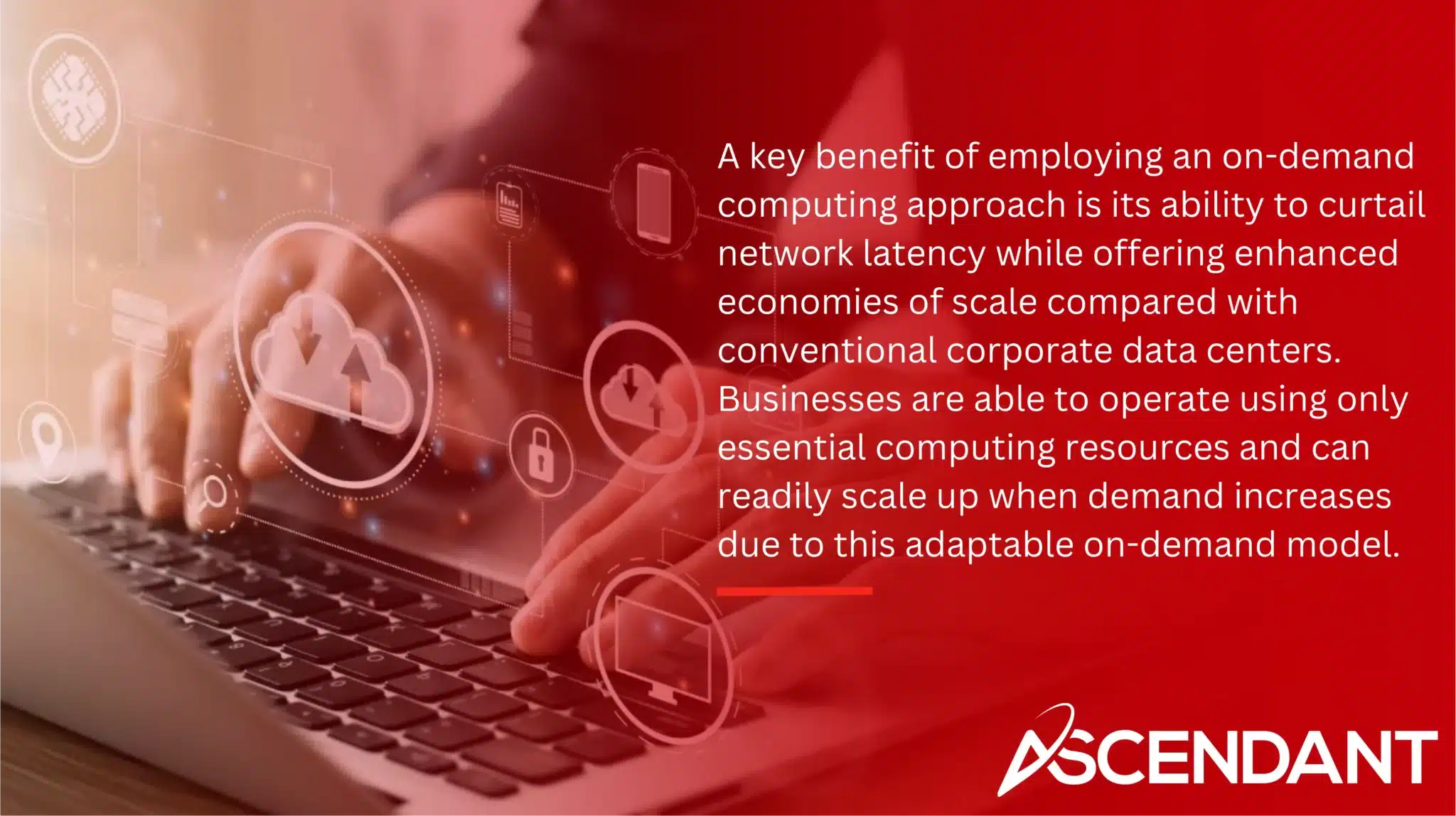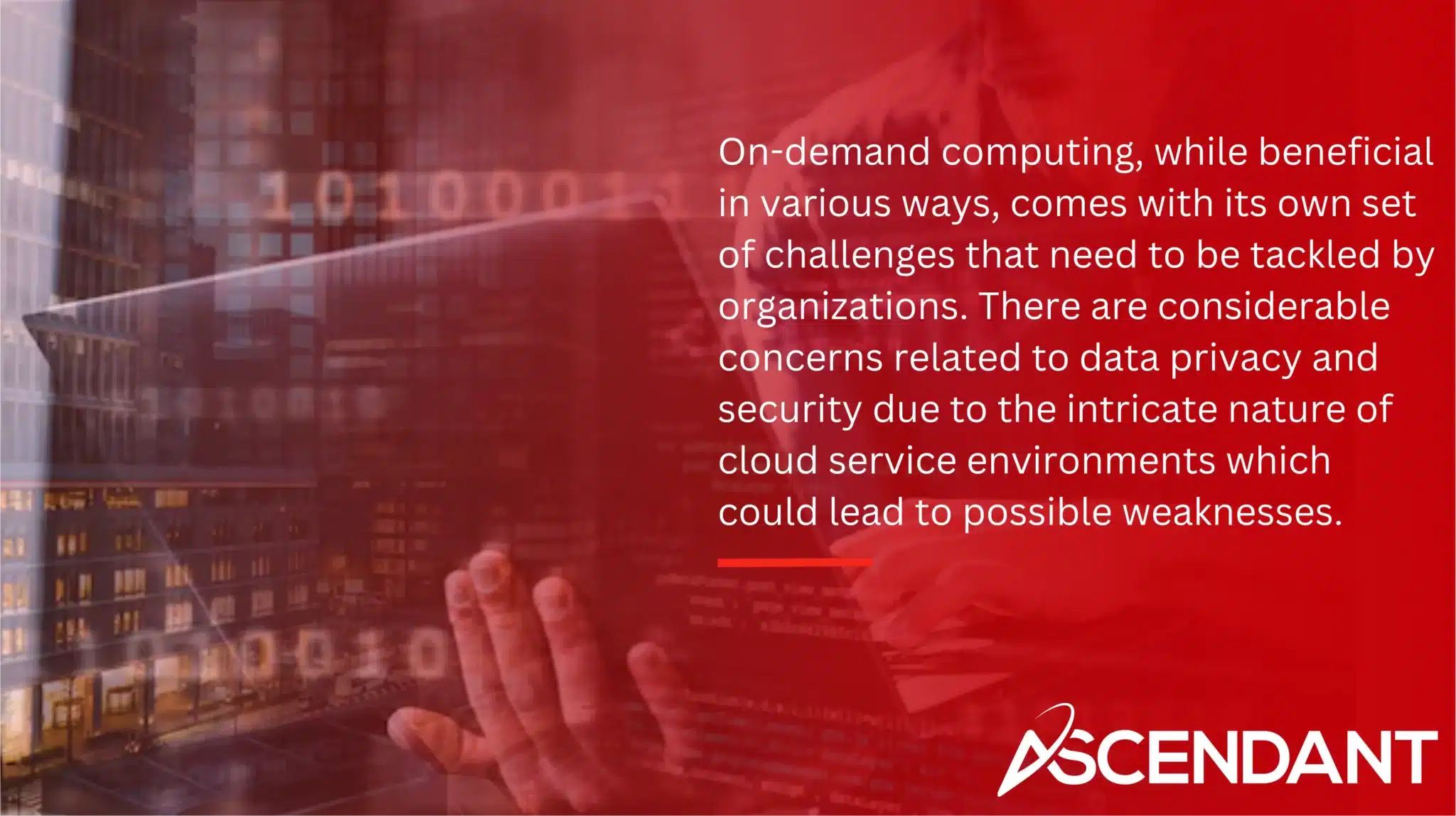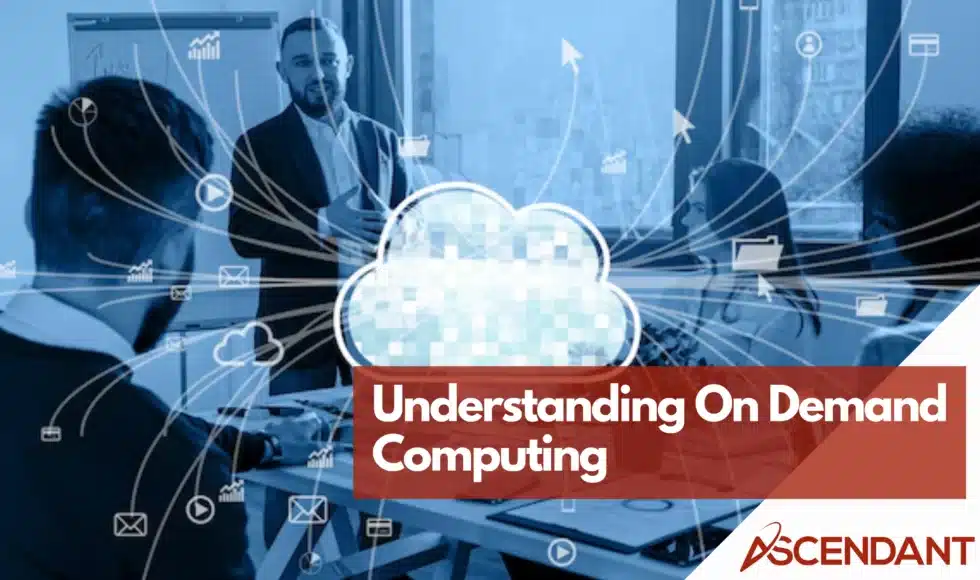On-demand computing lets businesses access and pay for IT resources as needed. This model boosts scalability and cost-efficiency. This article explores how on-demand computing works, its benefits, and real-world uses.
Key Takeaways
- On-demand computing offers scalable, pay-per-use IT resources, allowing businesses to efficiently respond to changing demands while minimizing operational costs.
- Key advantages include cost efficiency through a pay-as-you-go model, scalability to adjust resource usage as needed, and reduced operational tasks, enabling IT teams to focus on strategic initiatives.
- Real-world applications span various industries, including healthcare, finance, and software development, enhancing data management, agile deployment, and business intelligence capabilities.
What Is On Demand Computing?
Demand computing represents a paradigm in the realm of business, characterized by scalable and pay-as-you-go IT resources that cater to an organization’s fluctuating needs. This innovative approach eclipses traditional IT frameworks through its dynamic allocation of computing power, ensuring businesses can adeptly navigate the waters of ever-shifting computational demands.
At this model’s core lies a principle: delivering only necessary quantities of computing prowess instead of superfluous bulk. By keeping on-hand computational assets at bay until required for expansion, companies not only elevate efficiency but also achieve noticeable cost reductions. Leveraging cloud services facilitates ongoing innovation without inflating operational expenses.
On-demand computing extends its benefits globally, significantly driving up operational productivity. Entities wield greater authority over their technological allotments with heightened dexterity in managing them across platforms like AWS—with its arsenal exceeding 200 distinct cloud solutions—easing the burden posed by unpredictable spikes or ebbs in demand by offering elastic scaling options.
This adaptive mechanism Smoothens pathways to swiftly harness cutting-edge technologies and sophisticated tools for app development—a boon for any enterprise vying for supremacy amidst fierce market competition.
How On Demand Computing Works
At the heart of on-demand computing lies the provision of IT resources via the internet, which is referred to as cloud computing. Providers such as AWS manage a wide array of IT essentials—including servers, storage solutions, and applications—accessible over the internet through cloud services. This arrangement allows for rapid deployment of applications, drastically diminishing time-to-market durations.

A key benefit of employing an on-demand computing approach is its ability to curtail network latency while offering enhanced economies of scale compared with conventional corporate data centers. Businesses are able to operate using only essential computing resources and can readily scale up when demand increases due to this adaptable on-demand model.
A multitude of functions can be supported by leveraging cloud services ranging from robust data analytics capabilities to comprehensive security coverage within the realm that encompasses various cloud computing services.
Virtualization Technology
In the realm of on-demand computing, virtualization technology is key in separating physical resources from their use cases, thereby enabling a single hardware platform to support various virtual systems and operating systems concurrently. Consequently, enterprises are no longer required to commit capital towards acquiring and sustaining dedicated hardware since these virtualized resources can be upscaled and administered with greater efficiency.
The practice of employing virtualization within on-demand computing negates the necessity for obtaining new hardware or investing in its continual care and modernization. By doing so, it significantly cuts down operational expenditures while simultaneously freeing up businesses to direct their attention towards strategic development rather than focusing on managing infrastructure.
Cloud Service Models
Providers of cloud services deliver a trio of primary offerings: Infrastructure as a Service (IaaS), Platform as a Service (PaaS), and Software as a Service (SaaS). Each type provides specific functions designed to meet varying business requirements.
With IaaS, users gain access to data storage, virtual or physical servers, and comprehensive networking capabilities. This variety allows for extensive flexibility and control over the management process, distinguishing it from other models of cloud service delivery. It is particularly well-suited for businesses that require the ability to manage their own infrastructure yet want to leverage the scalable nature and cost-effectiveness provided by cloud technology.
PaaS serves those who prefer not to be encumbered by managing underlying infrastructure issues during application deployment. Offering an environment conducive to agile development practices along with swift rollouts, PaaS stands out among software developers seeking efficiency without sacrificing quality or functionality.
In contrast, there are SaaS where applications are managed online by providers within the cloudscape—where users can engage with various software offerings minus concerns related to upkeep or continual maintenance tasks.
Key Benefits of On Demand Computing
On-demand computing presents numerous advantages that are compelling for companies, with cost efficiency being a standout benefit. The ability to reduce operational expenses comes from the implementation of a pay-per-use model, which allows businesses to only spend on the resources they actually consume, leading to improved financial oversight.
On-demand computing delivers substantial scalability and adaptability. Companies can adjust their resource usage in response to fluctuating demand levels, promoting efficient use of assets. It diminishes the burden of routine operational tasks so that IT staff can devote their attention to more high-level strategic work.
Cost Efficiency
On-demand computing’s pay-as-you-go pricing structure ensures that businesses incur expenses solely for the resources they consume, thereby eliminating superfluous costs. By transitioning from static to dynamic costs, companies can experience a reduction in their total spending. There are several payment schemes on offer, such as subscriptions and reserved instances, all of which carry distinct financial repercussions. This variety allows enterprises to select an option most suited to their specific requirements.
Small and medium-sized businesses stand to gain considerably from this model of cost-efficiency provided by demand computing since it affords them the opportunity to scale up operations with minimal initial outlay. This advantage serves to diminish their operating costs over time.
Scalability and Flexibility
Computing resources can be scaled up or down with exceptional flexibility through on-demand computing, which aligns closely with a business’s fluctuating needs. This dynamic approach prevents excessive provisioning and promotes efficient utilization of resources. Organizations are thereby empowered to calibrate their IT infrastructure in response to actual demand, resulting in cost efficiencies.
By shedding the limitations inherent in conventional it infrastructure, companies gain the ability to administer their computing resources more adeptly and adapt swiftly to evolving demands.
Reduced Operational Tasks
The substantial benefit of on-demand computing lies in the decrease of operational chores. Essential tasks such as load balancing, patch management, and disaster recovery are administered by cloud providers like AWS. This delegation of duties enables companies to concentrate on strategic developments and inventive efforts instead of mundane upkeep.
By lessening the necessity for internal IT staff to handle resource maintenance, businesses can channel their attention towards projects that drive value, thereby boosting productivity and fostering expansion.
Real-World Applications of On Demand Computing
Computing on demand plays a significant role in numerous sectors by offering versatile applications. Within the healthcare industry, it facilitates quick exchange of data, improving patient services with tools such as telemedicine and efficient management of patient information. Both financial service providers and video game industries utilize computing on demand to cater to their unique requirements.
The importance of this technology continues to grow within our digital era, ensuring swift accessibility and enhanced efficiency for various industries.
Data Backup and Disaster Recovery
Cloud computing makes data backup and disaster recovery easier and more cost-effective for businesses. Utilizing cloud-based services enables businesses to back up data efficiently and quickly restore files in case of disasters, ensuring minimal downtime and maintaining business continuity.
Data backup and disaster recovery are crucial for maintaining business continuity in the event of data loss, making on-demand computing an essential component of modern IT strategies.
Software Development and Testing
Computing on demand empowers software teams to adopt agile methodologies, promoting steady integration and deployment. It allows for swift creation of testing environments, which improves the productivity and success rate of software initiatives.
Leveraging on-demand resources offers developers enhanced flexibility and expedited testing capabilities. This approach enables them to swiftly respond to the ever-changing computing demands by fostering rapid innovation and iteration within their projects.
Business Intelligence and Analytics
Businesses are progressively leveraging on-demand computing to manage substantial datasets for instant analytics, enhancing decision-making processes. This facility empowers enterprises to interpret data at the moment it is produced, yielding insights that bolster strategic choices and augment business effectiveness.
Serving as a pivotal catalyst for sophisticated analytics and business intelligence initiatives, on-demand computing assists companies in maintaining their competitive edge in a world where data-driven strategies prevail by capitalizing on available computing power.
Challenges and Considerations

On-demand computing, while beneficial in various ways, comes with its own set of challenges that need to be tackled by organizations. There are considerable concerns related to data privacy and security due to the intricate nature of cloud service environments which could lead to possible weaknesses. To safeguard their information and applications, enterprises must enforce strong security protocols.
Companies might encounter difficulties like data breaches, hurdles in meeting compliance standards, and poor management of resources. In selecting an appropriate cloud service provider for on-demand services, it is essential for businesses to consider their unique demands such as adherence to regulations, robust security postures, and the capacity for scaling operations accordingly.
Security Concerns
Misconfiguration, poor identity management, and insecure application programming interfaces (APIs) are frequently occurring weaknesses in cloud security. It is imperative to enforce robust encryption methods alongside stringent access controls to protect confidential data within the cloud infrastructure. Strengthening of cloud security can be achieved by adopting a Zero Trust model that eliminates all implicit trust given to users or devices.
An overwhelming 93% of leading businesses convey profound apprehension about the possibility of experiencing data breaches in their respective cloud environments. This underscores the critical need for proactive measures in tackling these pressing security concerns.
Managing Shadow IT
The growth of shadow IT presents considerable challenges, with employees engaging in the use of unapproved cloud applications. This practice complicates an organization’s ability to oversee and protect its data security effectively. To counter these threats, organizations are encouraged to employ tools that provide visibility so they can supervise and regulate non-authorized applications.
It is vital for businesses to cultivate a greater understanding among their workforce regarding the issues related to shadow IT as a means of reducing dangers tied to unsanctioned applications. The deployment of Cloud Access Security Brokers (CASBs) serves as an additional measure by enhancing oversight and governance over cloud usage within companies.
Future Trends in On Demand Computing
The market for cloud computing is anticipated to experience notable growth, underscoring its escalating relevance across various industries. Predicted future developments indicate that demand computing will emerge as the predominant model employed by businesses due to its adaptability, scalability, and cost-saving advantages.
The convergence of AI/ML with cutting-edge technologies such as quantum computing and 5G is poised to introduce unprecedented capabilities and improve overall performance. Such a combination will promote cooperative efforts in the field of AI/ML, allowing teams around the globe to exchange data and insights without obstacles.
Forthcoming enhancements are expected to concentrate on bolstering security measures and regulatory compliance within cloud platforms tailored for AI/ML operations. This focus ensures that enterprises can adopt these technological advancements in a secure and efficient manner.
Selecting the Right Cloud Service Provider
Selecting an appropriate cloud service provider is essential to fully leverage the advantages of demand computing. Begin by ascertaining your particular business needs and base-level prerequisites, confirming that the services provided by the CSP are in harmony with your goals.
Evaluating Service Offerings
In evaluating Cloud Service Providers (CSPs), scrutinize their certifications, since these are a testament to their compliance with established industry best practices and norms. Such an evaluation will assist in narrowing down the list of suppliers that satisfy your specific requirements for security and compliance.
It is crucial to verify that the technology offered by the cloud provider is compatible with your current infrastructure and fosters your strategic goals over time, thereby enabling seamless integration and providing scalability options.
Assessing Costs and Pricing Models
It is essential to scrutinize billing for transparency, paying special attention to any concealed charges and confirming that the provider presents a straightforward delineation of costs. Equally critical is the assessment of service-level agreements (SLAs), as these documents usually detail the intended levels of service and offer details regarding reimbursement should there be lapses in service.
Acknowledging what vendor lock-in entails and planning exit strategies are key components in controlling potential expenses that may arise when switching to alternative providers down the line. One must also take into account ancillary costs associated with cloud services, including those stemming from productivity setbacks during periods when services are not operational.
Summary
Demand computing presents a transformative strategy for handling IT resources that ensures scalability, cost-effectiveness, and minimizes operational duties. Utilizing the power of cloud computing enables organizations to meet fluctuating demands head-on, streamline their processes, and concentrate on strategic expansion.
Going ahead, the assimilation of cutting-edge technological advancements along with ongoing enhancements in security protocols will amplify the capabilities inherent in demand computing. Adopt this innovative technology to maintain your competitive edge and discover fresh avenues for innovation and progress.
 Frequently Asked Questions
Frequently Asked Questions
What is on-demand computing?
On-demand computing is a flexible business model that offers scalable IT resources on a pay-per-use basis, enabling users to access and adjust their computing needs as required.
This approach enhances efficiency and cost-effectiveness in IT resource management.
How does on-demand computing work?
On-demand computing delivers IT resources via cloud services, allowing for quick deployment and scalability of servers, storage, and applications as needed. This model ensures you only pay for what you use, enhancing efficiency and flexibility.
What are the benefits of on-demand computing?
Computing on demand provides substantial advantages like cost savings, the ability to scale, and adaptability, which help companies optimize their processes and focus on strategic efforts. It alleviates the load of day-to-day operational tasks and facilitates nimbler choices in decision-making.
What are the challenges of on-demand computing?
Computing on demand introduces several challenges that must be dealt with, including concerns over data privacy and security, issues pertaining to regulatory compliance, as well as controlling shadow IT.
It is vital to confront these obstacles in order to maintain a secure and efficient utilization of resources provided on demand.
How can I choose the right cloud service provider?
Choose the right cloud service provider by assessing their certifications, service offerings, cost transparency, and how well they align with your business needs and long-term goals.
This ensures you select a provider that fits your specific requirements.

